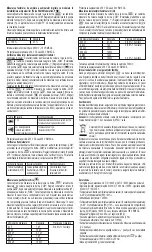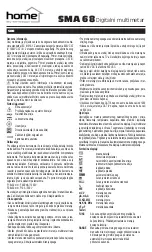
Input voltage: 200 mV – 10 V AC RMS
Over-voltage protection: 250 V DC or 250 V AC RMS
Duty factor measurement
Connect the red probe cable to the
socket, and the black one to the
“COM” socket. Set the dial to the “Hz%” measurement range. Use the “Hz/
DUTY” pushbutton to set the duty factor (%) function. Connect the measure
-
ment probe to the circuit to be measured.
Note: Do not exceed the input voltage as this will damage the instrument.
Measuring range Resolution
0 – 100%
0.1%
Input voltage: 200 mV – 10 V AC RMS
Over-voltage protection: 250 V DC or 250 V AC RMS
Diode and interruption testing
Diode testing:
Connect the red probe cable to the
socket, and the
black one to the “COM” socket (the red probe is for “+” polarity). Set the dial
to the position. Use the “FUNC” pushbutton to set the diode testing (
) function. Connect the red probe cable to diode’s anode, and the black
one to its cathode. The display will show the diode’s approximate forward
voltage. If the connection is reversed, “OL” will appear in the display.
Interruption testing:
Connect the red probe cable to the
socket, and
the black one to the “COM” socket. Set the dial to the
position. Use the
“FUNC” pushbutton to set the interruption testing (
) function. Connect
the measurement probe to the circuit to be tested. If the circuit is connected
to a power source, switch of the power source and discharge the capaci-
tors before starting measurement. Short-circuits (less than 60 Ω) will be
indicated by the built-in buzzer.
Function Resolution
Measuring environment
1 mV
Measurement current:
approx. 1 mA
Idle voltage: approx. 2.8 V
The built-in buzzer will
Idle voltage less
activate below 60 Ω
than 700 mV
Overload protection: 250 V DC or 250 V AC RMS
Transistor testing
Connect a transistor testing socket to the instrument so that its “COM”
connector plugs into the multimeter’s “COM” socket, and its “IN” connector
plugs into the multimeter’s
socket. Set the dial to the “hFE” measure-
ment range. Insert the transistor to be tested into the testing socket. Ob
-
serve the pin layout and transistor type (PNP, NPN).
Measurement limit
Description
Measuring environment
hFE
Estimated hFE on display Base current: 10 µA
(0 - 1000)
Vce: approx. 2.8 V
Capacity measurement ( )
Connect the red probe cable to the
socket, and the black one to the
“COM” socket. Set the dial to the
position. Use the “FUNC” pushbutton
to set the capacity measurement (nF) function. Connect the measurement
probe to the circuit to be measured. If the capacitor to be measured is con-
nected to a circuit, switch of the power source and discharge the capacitors
before starting measurement. Note: Capacity measurement only works with
automatic measurement range selection. When performing measurements
please note that the larger the capacity (µF) being measured, the more time
it takes for the multimeter to take an accurate measurement.
Measurement limit
Resolution
Accuracy
4 nF
1 pF
±(4.0% 15 digits)
40 nF
10 pF
400 nF
0.1 nF
4 µF
1 nF
40 µF
10 nF
200 µF
100 nF
Overload protection: 250 V DC or 250 V AC RMS
Resistance measurement (Ω)
Connect the red probe cable to the
socket, and the black one to
the “COM” socket. (The red probe cable is “+” polarity). Set the dial to the
position. Use the “FUNC” pushbutton to set the resistance measure-
ment (Ω) function. If the resistor to be measured is connected to a circuit,
switch of the power source and discharge the capacitors before starting
measurement.
Measurement limit
Resolution
Accuracy
400 Ω
0.1 Ω
±(0.8% 3 digits)
4 kΩ
1 Ω
±(0.8% 1 digit)
40 kΩ
10 Ω
400 kΩ
100 Ω
4 MΩ
1 kΩ
40 MΩ
10 kΩ
±(1.0% 2 digits)
Open circuit voltage: under 700 mV
Over-voltage protection: 250 V DC or 250 V AC RMS.
Battery and fuse replacement
If the “
” icon appears on the display, the batteries require replacing.
The fuse only needs to be replaced rarely due to errors associated with
use. Prior top replacing the battery/fuse, turn off the instrument and unplug
the probe cables. For battery replacement, use a screwdriver to remove the
screw from the rear panel. For fuse replacement first remove the instrument
from its case then remove the screws from the rear panel. Replace the
battery/fuse. Observe the correct battery polarity. Replace the cover and
tighten the screws.
Warning:
Before opening the instrument, make sure that the probe cables have been
removed from the measuring circuit. Replace and tighten the screws so that
the device operates in a stable manner during use and accident hazards
are avoided.
Accessories:
• Instructions for Use • probe cable • transistor testing
socket • 9 V (6F22) battery • box
Waste equipment must not be collected separately or disposed
of with household waste because it may contain components
hazardous to the environment or health.
Used or waste equipment may be dropped off free of charge at the point of
sale, or at any distributor which sells equipment of identical nature and func-
tion. Dispose of product at a facility specializing in the collection of electronic
waste. By doing so, you will protect the environment as well as the health
of others and yourself. If you have any questions, contact the local waste
management organization. We shall undertake the tasks pertinent to the
manufacturer as prescribed in the relevant regulations and shall bear any
associated costs arising.
Batteries, whether alkaline or rechargeable, must not be handled together
with regular household waste. It is the legal obligation of the product’s user
to dispose of batteries at a nearby collection center or at a retail shop. This
ensures that the batteries are ultimately neutralized in an environment-
friendly way.
Specifications
• measurement category: CAT III 1000 V, CAT IV 600 V and Category 2
contamination
• fuses: 6x30 mm, F 400 mA / 1000 V quick blow; 6x30 mm, F 10 A / 500
V quick blow
• ambient temperature and humidity: 0 – 40 °C (<80% relative humidity)
• operating altitude: <2000 m
• storage temperature and humidity: -10 – 60 °C (<70% RH and remove
the battery)
• maximum allowed voltage between the measurement device and ground:
1000 V DC or 750 V AC RMS
• display: 4 digit LCD display
• sampling frequency: approx. 3 / second
• power supply: 9 V (6F22) battery
• reading over measurement limit: “OL” appears in the display window.
• polarity indication: “-” is displayed for negative polarity.
• exhausted battery: “
“ icon appears on the display.
• dimensions: 195 mm x 92 mm x 55 mm
• weight: approx. 380 g (including battery)






































